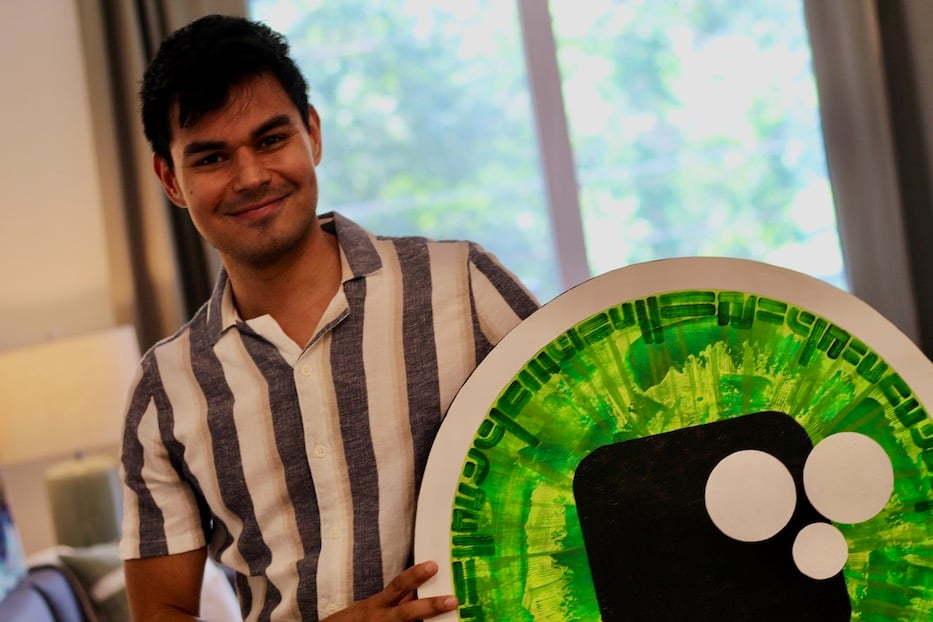
Painting | Arts & Culture | Visual Arts | Whalley/Edgewood/Beaver Hills | Wooster Square | Arts & Anti-racism
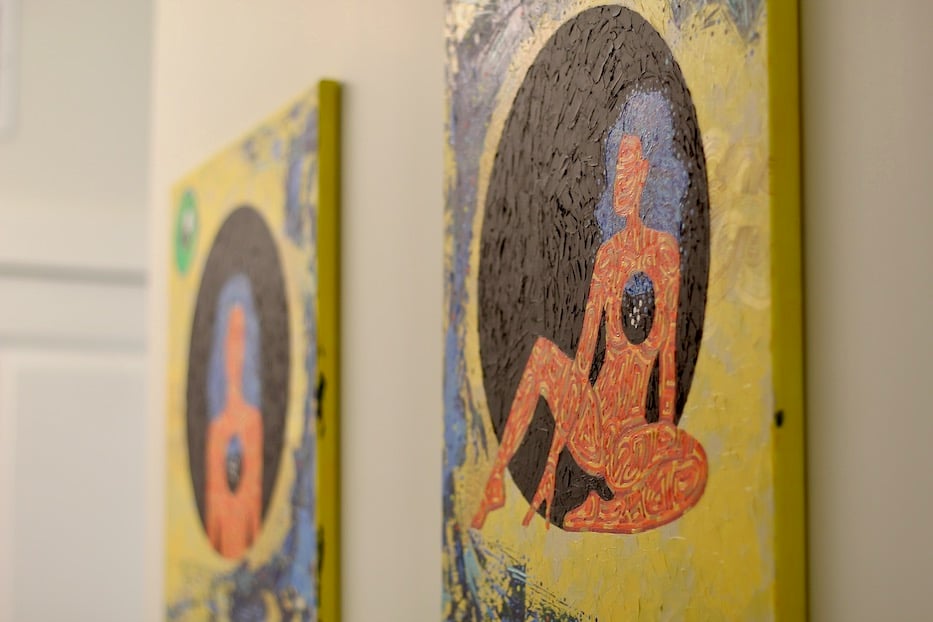
Ricardo Gutiérrez, "Metanoia Phase 2, Acrylic on canvas. The artist installed the pieces at Olive & Wooster to display the new series, entitled Through My Eyes, for this reporter. Lucy Gellman Photos.
The woman looks as though she could be on fire, rising from the canvas in a labyrinth of oranges, reds and yellows. From her brow, a thick, curly blue mane dances past her shoulders, as if her head is the wick, and her brain is ablaze. Behind her, a perfect circle threatens to swallow her up in its crackly black depths. It’s no match for her: she sticks one toe out, putting a foot back into the world. Even in her tentativeness, she is cementing herself firmly within it.
The image comes from Through My Eyes, a new, multi-part body of work from the artist Ricardo Gutiérrez inspired by his own relationship with mental health and LGBTQ+ visibility. For the artist, whose series Urabá told a profound story of his creative foundation in Colombia, Through My Eyes marks a visual and narrative shift, giving viewers an intimate look into the artist’s past, present and future.
It is at turns abstracted, figural, whimsical and deeply psychological, the kind of work that both invites and demands close looking to tell its full story. It is also deeply rooted in New Haven, the artist’s longtime and adopted home after Colombia and New Jersey.
“This collection is totally different—it’s another face of Ricardo,” Gutiérrez said on a recent episode of WNHH Community Radio’s “Arts Respond,” speaking from his home studio in New Haven’s Edgewood neighborhood. “I would say that this exhibition is more expressionist. It’s about mental health, the connection of human beings with the universe.”
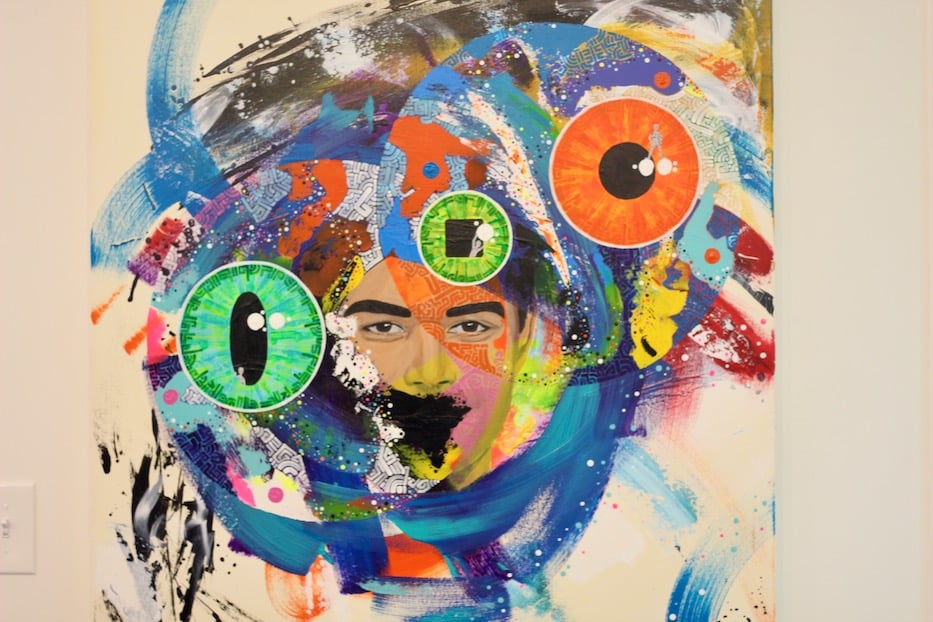
Ricardo Gutiérrez, "Through My Eyes" Acrylic on canvas.
Together and apart, those pieces tell the story of moving out of his own trauma, and into a place of self-acceptance and deep reflection. After completing Urabá in 2021, Gutiérrez would lie awake for hours in his bed, thoughts racing. He could envision a deep, looming black hole, hovering somewhere just above him. Inside, there were all the ways “I was living my life for others,” he remembered. He wanted to be permanently on the other side of it.
"When we're in that black hole, we don't see the beauty of life, the beauty of the universe," he said. It wasn’t just him, he added: when he looked around, he saw that many of his friends were also struggling with depression and anxiety. Through My Eyes was his way of taking action, one brushstroke at a time.
It required going back—way back—to go forward both mentally and artistically. Growing up in a majority-Catholic country, Gutiérrez knew he was gay from the time that he was very young, but remained quiet about his sexual orientation for years. In his family, to be LGBTQ+ and out wasn’t thought of as acceptable. At school, his classmates harassed him verbally, in a manner that still stings when he thinks about it. For years, “I didn’t want to live, honestly,” he said.
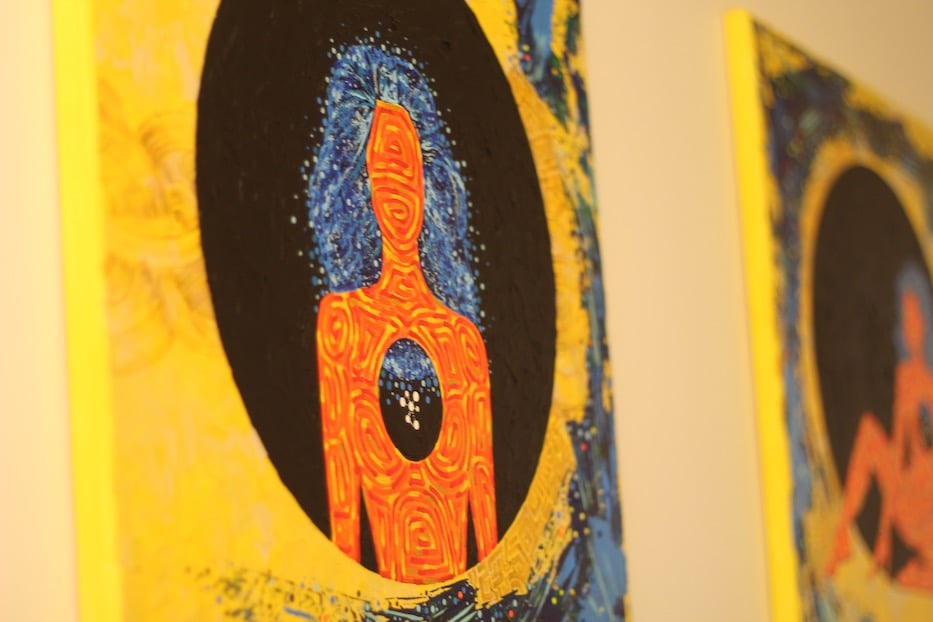
Ricardo Gutiérrez, "Metanoia Phase 1," Acrylic on canvas.
Part of that was also the country’s political backdrop. While Colombia is outwardly regarded as one of the more progressive countries for LGBTQ+ rights, it has long been (and remains) extremely dangerous and violent for LGBTQ+ and particularly trans individuals. It was within this context, Gutiérrez said, that he first realized he was gay, and then realized that he would not face immediate acceptance from any one part of his community.
After picking up a book of his mother’s on meditation, he turned to the practice as a way to remain calm. “That helped me to create, like, a bubble, and not let anyone hurt me with all the things that they used to say to me,” he said. “Even my family.”
And yet, for years Gutiérrez couldn’t be himself. He felt like he was acting, he said. At home, no one wanted to talk about the possibility that someone in the family could be gay. His father, who is himself an artist, expected his Gutiérrez to be an engineer. “I was miserable,” he remembered. It was not until he left for university, where he ultimately studied graphic design at the Fundación Universitaria Bellas Artes Medellín, that he started to feel free of those expectations.
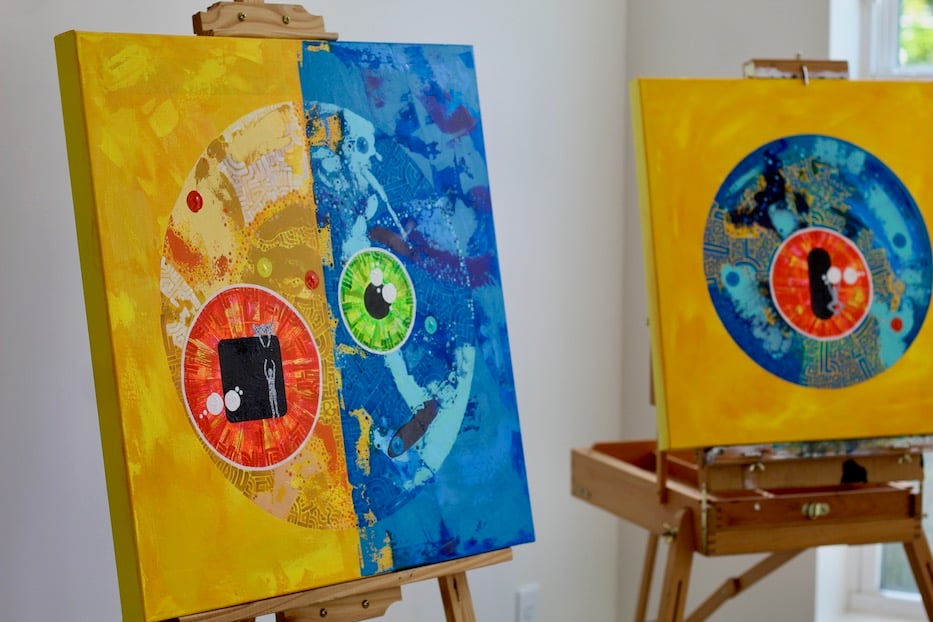
Ricardo Gutiérrez, "Humanity/Humanidad" and "Resilience," both acrylic on canvas.
What got him through it—what still gets him through it—is his artwork. In Urabá, that meant shedding a light on a home (or as he phrases it now, a first home) when it was thousands of miles away. In the months afterward, the exhibition led to new work, including a portrait of Black engineer William Lanson that now lives at the New Haven Museum, and collaborations with Artspace New Haven and Armada Brewing.
But it was not until earlier this year, around the same time that Gutiérrez was also named one of Connecticut Magazine’s “40 Under 40,” that Through My Eyes started taking shape. Around him, Gutiérrez could still feel the pulsing edges of a darkness that he was outside of, but knew intimately. He realized that through his artwork, he could both address it, and inspire others to talk about their own struggles with mental health.
A viewer can see that from his first new canvas to his last, several of which Gutiérrez displayed at the Olive & Wooster apartments on Union Street earlier this summer, and has since lent out to galleries in both Connecticut and New York. In Metanoia, which extends in layered, thick acrylic paint over four canvases, Gutiérrez depicts the same woman moving from solid, surrounding darkness into light, a unicorn nuzzling her as she crawls from one into the other. By the end, she is surrounded by marbled, sunshine-yellow color, standing as a large, bright eyeball blooms behind her.
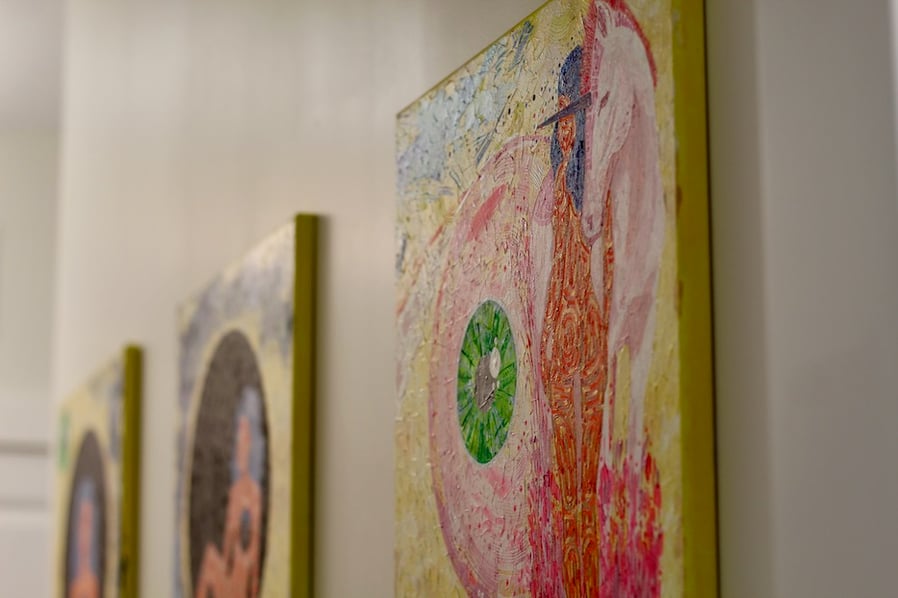
Detail, Ricardo Gutiérrez, "Metanoia Phase 4."
It’s the journey that she takes to get there that Gutiérrez is most interested in, he said. Where Metanoia begins, the woman’s slender, flame-colored figure stands in the center of a perfect black circle, her blue hair fanning out around her as spots of blue and white dance at its edges. A viewer can’t read her expression: her face has been consumed by this flame color, as if she is molten hot. Where her heart might otherwise be, a white molecule floats in a small, second black circle.
If a viewer leans in closely enough, Gutiérrez’s own words—”I used to be in that black hole. That's why I'm talking about it. I used to be blind. I was unhappy. I was depressed.”—seem to rise and bubble from the canvas.
But they also help his figure move forward. Across the four panels, viewers watch as she makes the journey from stillness inside the black hole to motion on its periphery, as she crawls toward the light, all but clawing her way to the other side. The unicorn, which appears in “Metanoia: Phase 3” and remains in “Metanoia: Phase 4,” represents the power of meditation in the artist’s own life. A number of eyeballs that float throughout, meanwhile, are meant to reflect the big, broad universe waiting for her among those who are fully alive, Gutiérrez said.
Named after the theological notion of metanoia, or a shift in one’s fundamental belief system, the series is meant to both pay homage to the matriarchs in the artist’s life, with whom he identifies strongly, and show his own transformation. For years, “I was just living and trying to find a way out of that darkness.” No longer: the eyes that greet his figure on the other side are a sign that she has made it fully back into the world of the living.
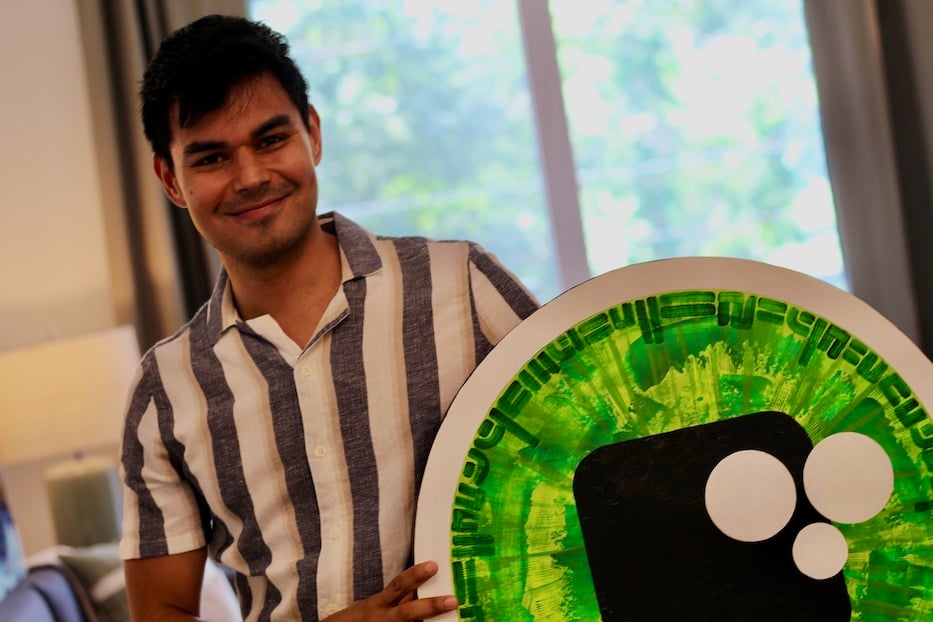
The artist. “Since I got out of the darkness, my life has changed for good,” he said.
It flows into his subseries’ Empathy and his Four Seasons in New Haven, the latter of which captures spaces across the Elm City that have made it feel like home. In the first, Gutiérrez has expanded on his theme of eyeballs as part of the universe itself, splitting the scenes into phases of depression and resolution. In the second, he has pictured New Haven in all four seasons, documenting how the city transforms with a little bit of his own magic thrown in.
While they seem to exist on different planes of existence, the works have a sort of cross-talk, with the artist as their logical meeting point. In “Humanity,” for instance, a canvas is split evenly into blue and yellow halves, a perfect, complete circle rotating between the colors. On the left, a tiny figure raises his arms, trying to get out of a black box that doubles as the center of an eye.
The seasons, meanwhile, imbue Through My Eyes with a sense of delight there that is very much contagious, urging a viewer to look at the city with a fresh perspective. On a canvas that explodes with white, pink and blue, Gutiérrez ushers in spring with a detail of St. Michael’s Church in April, around the time of the annual Wooster Square Cherry Blossom Festival.
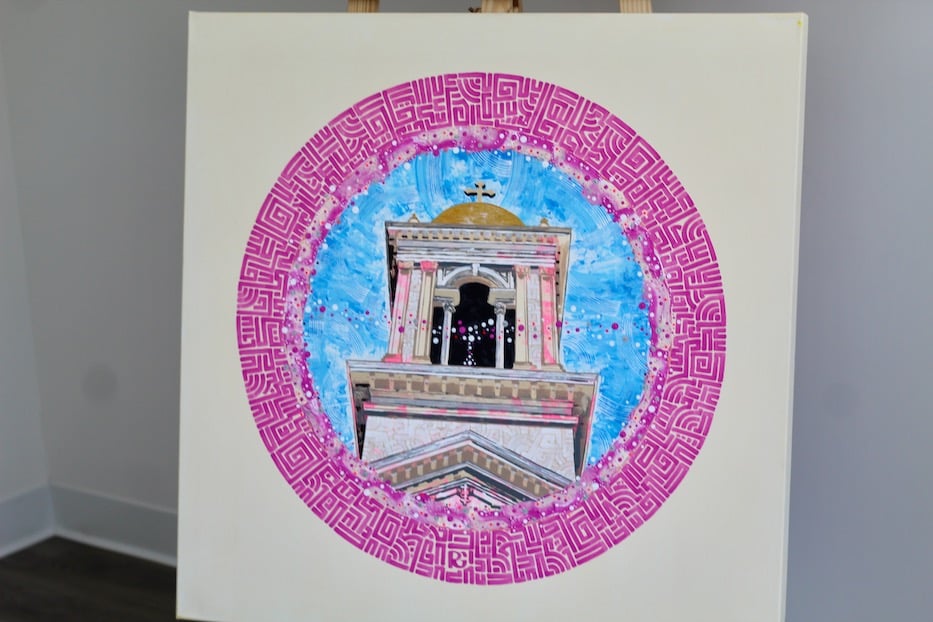
Inside a closed, rose-colored frame that is part of the work, pink and white bubbles of color float through the air, leaving splashes of color in their wake. The church appears restored to a more glorious, earlier version of itself, with a gold dome that glitters in the sun. There is something completely new about the church, which towers over Wooster Square in a creamy, butter-yellow color that looks more suited for Italy than for New England. And no wonder: it was built in the late 19th century for a growing Italian immigrant community.
In the canvases around it, East Rock bursts into the reds and yellows of autumn, so vivid that the park appears ablaze. Edgewood Park soaks in a dappled, early-morning light, its underpasses made new and vibrant under a smear of bright blue sky. The Union and New Haven Trust Building beckons from an edge of the New Haven Green, the space reborn as it is blanketed in fresh snow.
Throughout, he has incorporated his now-signature molas, labyrinthine, intricate designs inspired ornate, bright and tightly woven textiles for which the Indigenous Gunadule people along the Gulf of Urabá are known. That meeting of worlds, he said, tells the story of the different places and people that make him into the creative he is—and have sustained him even in moments of deep darkness and difficulty.
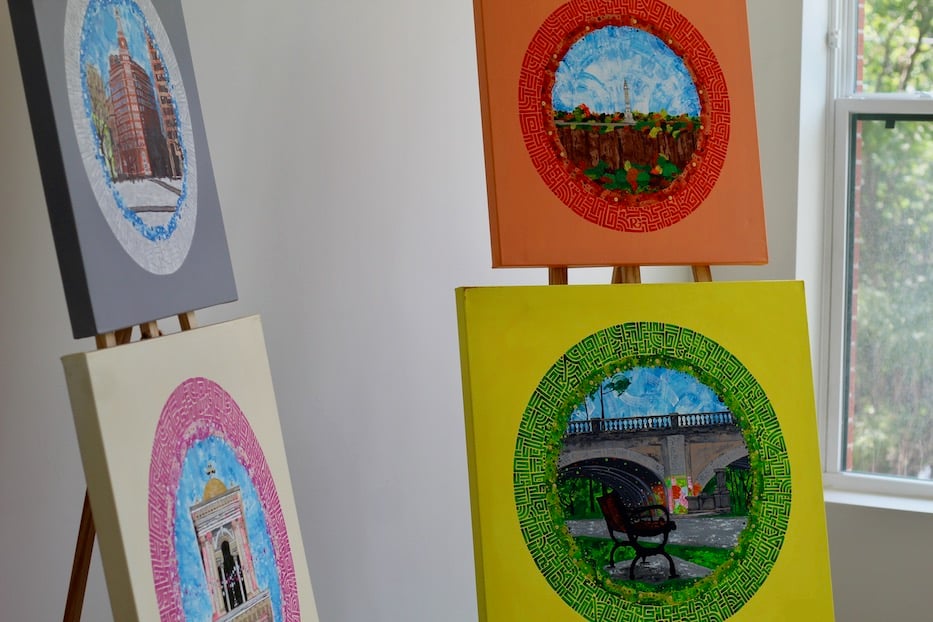
The four seasons.
Nowhere, perhaps, is his message clearer than in two works that bring the artist directly into the discussion of his own self-healing. In the titular Through My Eyes, a self-portrait after which the whole series is named, Gutiérrez looks out at the viewer, a smudge of black over his mouth and chin. Beneath thick, furrowed brows, his eyes don’t waver, steady as they pierce the space in front of them. Around his head and neck, colors swirl and dance in every direction, in blues and yellows that swirl into eyeballs and circles of color.
It’s a fitting pendant to “Plenitud” (“Fullness”), in which a phoenix occupies an entire half of the canvas. From the lower right of the image, it rises into the air, wings a fiery, brilliant red that is cut with stretches of orange, yellow, and black. At points, Gutiérrez has handled the color so delicately that it does not appear feathered so much as stained glass, or perhaps the thin, translucent chitin of a butterfly’s wing.
The image is an especially victorious one: the bird flies forward, ascending further into the clouds, its beak open as if to speak. Behind it, a circle glows gold, unbroken surrounded by a mola to remind the artist whence he came. Where there was darkness, there now is only brilliant, blinding When he presents the work, Gutiérrez has included the caption “Una vez te sientas pleno, podrás volar y brillar cerca del sol sin quemarte.” “Once you feel full, you can fly near the sun without burning.”
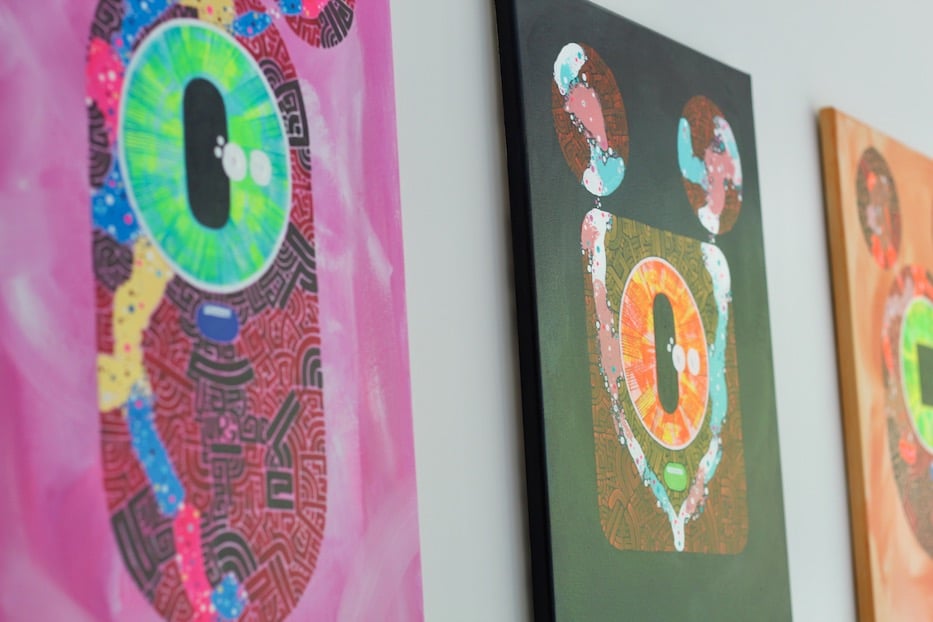
Gutiérrez's "FunChis."
With the pieces, which are the beating heart of this body of work, Gutiérrez said he hopes to help others move from their own personal darknesses into the full experience of living. When he looks around, he sees friends, colleagues and fellow artists who are struggling with depression, particularly under the weight and mental exhaustion of the last three years. He wants to be for others what some people have been for him.
“Somebody helped me get out of that darkness,” he said. “Some of my friends, they are alone in this darkness. They have these traumas where they don’t see the beauty of living anymore.”
He also wanted to end the series on a note of wonder and whimsy, and has nailed it with his “FunChis,” cartoon-like characters that seem almost human, as if they could walk out of the canvas and into a slightly more colorful version of the real world. Inspired by both his cat, Michis, and the Pokémon characters he loved as a child, Gutiérrez created the figures to remind his audience that there is always something lighter waiting, sometimes when one least expects it.
"Every human being, each of us, has the power to change the world,” he said. “We just need to make a decision. Once you make that decision, you will start seeing changes in your life. You can see your path clearly.”
“Since I got out of the darkness, my life has changed for good,” he later added, during a tour of the series at Olive & Wooster. “Nothing can stop me.”
To learn more about Ricardo Gutiérrez’s work, visit his Instagram page or his website.

